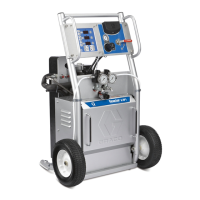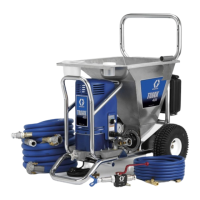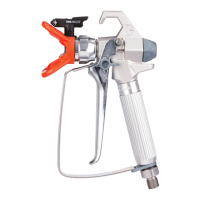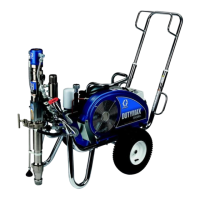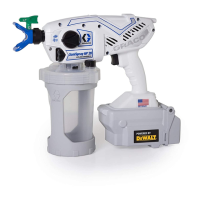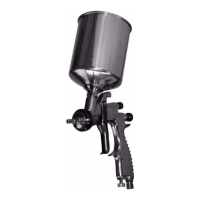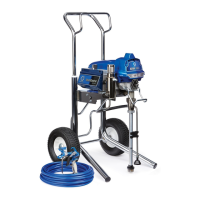308–626
9
Operation
INJECTION HAZARD
T
o reduce the risk of an injection or
splashing fluid in the eyes or on skin,
follow these precautions before remving,
cleaning or changing a spray tip or tip guard.
D
Do not hold your hand, body
, or rag in front of
the spray tip when cleaning or checking a
clogged tip.
D
Always point the gun toward the ground or into
a waste container when checking to see if the
spray tip is cleared.
D
Do not try to “blow back” paint; this is NOT an
air spray gun.
D
Follow the
Pressure Relief Procedure
on page
7 before wiping the fluid buildup of
f the gun or
spray tip, before removing the tip guard or the
spray tip, and whenever you are instructed to
relieve the pressure.
WARNING
How to Clear or Clean a
Clogged Spray Tip.
NOTE:
Clean the tip frequently during the daily opera
-
tion and at the end of the work day
. This helps keep
fluid buildup from drying and clogging the spray tip.
1.
Relieve the pressure.
2. Engage the trigger safety latch.
3. Use a solventĆsoaked brush to clean the tip.
4. Rotate the RAC IV tip handle (D)180
_. See Fig. 3.
5.
Start the pump.
6. Disengage the trigger safety latch. Trigger the
gun into a pail or onto the ground to remove clog.
7. Engage the trigger safety latch. Rotate the tip
handle to the spraying position.
8. If the tip is still clogged, lock the gun trigger
safety, shut off the sprayer and disconnect the
power source, and open the pressure drain valve
to relieve pressure. Clean the spray tip.
CAUTION
Do not soak the entire gun in solvent. Prolonged
exposure to solvent can ruin the packings.
How to Flush the Gun.
Always
flush the gun thoroughly whenever you are
done spraying for the day and before the fluid being
sprayed can dry or set up in the gun.
FIRE AND EXPLOSION HAZARD
T
o reduce the risk of a serious injury
from fluid injection, static sparking, or
splashing fluid in the eyes on or the skin,
follow these precautions when flushing.
D
Be sure the entire system and the flushing pails
are properly grounded. Refer to
Electrical
Grounding
on page 6.
D
Remove the spray tip from the gun.
D
Use the lowest possible fluid pressure.
D
Maintain firm metal-to-metal contact between
the gun and pail during flushing.
D
Follow the
Pressure Relief Procedure
on page
7 whenever you are instructed to relieve
pressure.
WARNING
1.
Use a solvent that is compatible with the wetted
parts in the gun and the rest of the system, as well
as with the material being sprayed.
2.
Follow the flushing instructions for your spray
system or pump.
3.
If you are flushing with water
, follow the water with
a rust inhibitor to protect the gun and packings
from corrosion.
4.
If necessary
, disassemble the gun and clean all
passages thoroughly with a soft bristle brush.
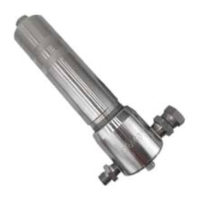
